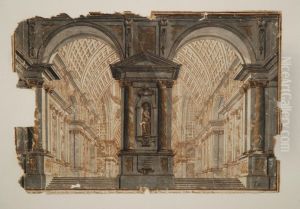Giovanni Canella Paintings
Giovanni Migliara, often incorrectly referred to as Giovanni Canella, was an Italian painter active during the late 18th and early 19th centuries. He was born on October 15, 1788, in Alessandria, Piedmont, in what was then the Kingdom of Sardinia. Migliara's initial career was not in the arts; he began as a decorator of theatrical scenery. This early work, however, laid the foundation for his acute sense of perspective and architectural detail, which would characterize his later artistic productions.
Migliara's transition to fine art came about after he moved to Milan. There, he was influenced by the neoclassical ambiance and the works of artists such as Giovanni Battista Ronchelli and Giuseppe Bisi, who were skilled at vedute, or detailed, large-scale paintings of city scenes. Migliara eventually specialized in this genre, becoming renowned for his architectural views and interior scenes, which were often embellished with historical or everyday life details. His works display a meticulous attention to architectural accuracy and perspective, and he was particularly skilled at using light to enhance the atmosphere of his scenes.
In addition to vedute, Migliara also painted religious and historical subjects. His talents earned him the position of a professor at the Brera Academy in Milan in 1833, where he influenced a generation of Italian painters. Migliara's works were sought after by collectors and patrons, including members of the Habsburg dynasty, and his paintings can be found in many art galleries and private collections around the world.
Migliara's health began to decline in the early 1840s, and he passed away on May 14, 1847, in Milan. His legacy continues to be appreciated by art historians and collectors, and his paintings are recognized for their contribution to the Lombard school of painting and the broader panorama of Italian art in the 19th century. It is worth noting that the name 'Giovanni Canella' might be confused with another Italian artist, Giuseppe Canella, who was also known for vedute and lived around the same period. However, their biographies and artistic styles are distinct.
